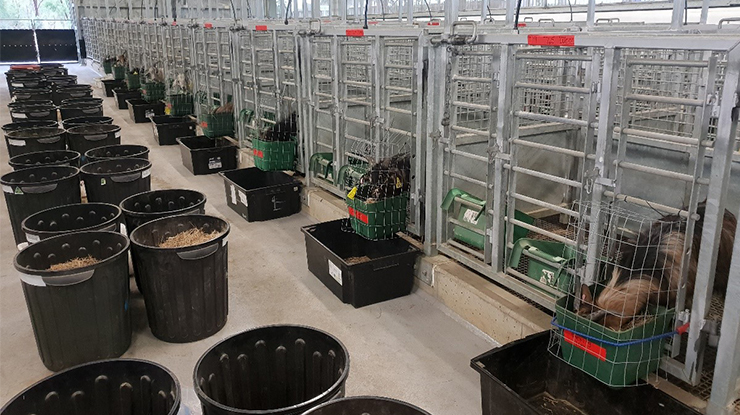 Rangeland goats feeding during one of the supplementation trials undertaken by The University of Queensland.
Rangeland goats feeding during one of the supplementation trials undertaken by The University of Queensland.
Response of rangeland goats to supplements
Key points
- New R&D is examining the impact of supplementation on rangeland goats to help producers increase live weight gains.
- Findings will inform the development of a simple cost-of-supplement calculator to assist producers make supplementation decisions.
An MLA-funded project determining rangeland goats’ response to feed supplementation is underway to help in the development of a simple cost-of-supplement calculator for goat producers.
Supplementation involves the provision of small quantities of a specific nutrient or nutrients to meet the requirements of an animal to achieve a target level of productivity.
An understanding of the likely response of rangeland goats to supplements is essential to support producers with their supplementation decisions; however, limited information is currently available.
MLA commissioned The University of Queensland to undertake the research and development project, led by Simon Quigley.
The objective of the project is to develop response relationships to a range of supplements which may be used by producers to increase live weight gain of young entire male rangeland goats.
The project initially completed a review of the nutritional requirements of rangeland goats before commencing a series of supplementation experiments. The project has now completed two experiments with young entire male rangeland goats, 16–20kg live weight, sourced from ‘Buffel Park’ and ‘Bullindgie’ stations in the Dirranbandi district of Queensland.
During the experiments, the goats were maintained in individual pens with intake and live weight gain measured over an 11-week period. Both experiments were conducted during periods of increasing day length to avoid the effects of declining photoperiod on feed intake.
Results to date
The first experiment was completed in 2019 and determined the goats’ response to increasing amounts of various supplements; a plant-based protein meal, lucerne, urea or whole cottonseed, as sources of dietary nitrogen.
The second experiment was completed in 2020 and determined the response of goats to increasing amounts of rolled wheat, rolled sorghum or lucerne pellets.
In both experiments, non-supplemented goats were fed Mitchell grass hay (4% crude protein, 40% digestibility) on which they essentially maintained live weight.
Goats consuming the highest amounts of the protein supplements in experiment 1 gained approximately 50–60g/day above the non-supplemented goats, while goats consuming the highest amounts of the sorghum and wheat supplements in experiment 2 gained approximately 70–90g/day above the non-supplemented goats.
At the end of both experiments, the goats were fed a commercially available pellet ad libitum, with average growth rates of 150–200 g/day recorded. Samples and data analysis from these experiments are currently in progress.
Potential to increase live weight gain
The experiments demonstrate the wide variation in both intake and live weight responses of rangeland goats to supplements and also that potential does exist to significantly increase live weight gain of this class of goat, when grazing a low quality basal diet.
The remaining experiments to be conducted within the project will determine the optimum crude protein content of supplements for young entire male rangeland goats. Validation of these responses and the economics of the different feeding strategies under grazing conditions will be required in the future.
The response data generated in the experiments will be used to develop a simple cost-of-supplement calculator to assist producers determine the relative costs of various supplements to achieve a targeted live weight gain for young entire male rangeland goats.
Full results from the project and the cost-of-supplement calculator is anticipated to be available to producers in late 2021.



